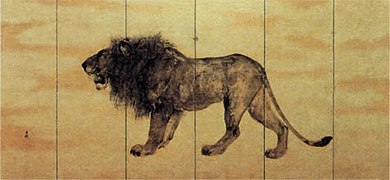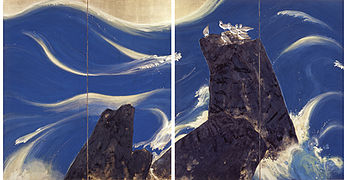Hirafuku Hyakusui
Hirafuku Hyakusui ( Japanese 平 福 百 穂 ; December 28, 1877 in Kakunodate , Akita Prefecture - October 30, 1933 ibid, actual name Teizō ( 貞 蔵 )) was a Japanese painter in the Nihonga style .
life and work
Hyakusui received his first lessons from his father, the painter Hirafuku Suisan (1844–1890). In 1894 he went to Tokyo and studied under Kawabata Gyokushō (1842-1913). From 1897 he studied painting in the department of painting in the Japanese style (Nihonga) at the Tokyo Art School, the forerunner of today's Tōkyō Geijutsu Daigaku . During this time he showed pictures at the exhibitions of the "Association of Young Japanese Artists" ( 日本 青年 絵 画 協会 , Nihon his kaiga kyōkai ) and the Nihon bijutsu kyōkai ( 日本 美術 協会 ) and was awarded prizes. In 1900 he founded, together with Yūki Somai (1875-1957), Fukui Kōtei (1856-1938) and others, the artists' association Musei-kai ( 无声 会 ) in order to lead the Nihonga direction at that time a more realistic direction.
Hakusui studied Western design for a year in the training facility of the Taiheiyō Gakai Kenkyūjo artists' association and gained a following with front pages and lively sketches for the Kokumin Shimbun newspaper. In 1914 his paintings were "turkeys" ( 七 面 鳥 , Shitchimenchō ) and "ducks" ( 鴨 , Kamo ) at the eighth exhibition of the Ministry of Culture Bunten ( 文 展 ) and at the Taishō exhibition, where they won third prizes. In 1916, together with Kaburagi Kiyokata , Matsuoka Eikyū and others, he founded the artist society Kinrei-sha ( 金 錫 社 ), which advocated artistic freedom and personal expression. In 1922 he became a member of the jury of the Teiten ( 帝 展 ), the successor to the Bunter.
In 1930 Hakusui visited Italy on the occasion of an exhibition of Japanese artists in Rome and also visited other European countries, including Germany. At the “Exhibition of the Works of Living Japanese Artists” bis one of his works, “The Abbot of Renge-ji”, was on view. Upon his return he became a member of the Academy of Arts . Two years later, in 1932, he was appointed to teach at the Tokyo Art School, but died the following year.
Hyakusui combined his painting in the Nihonga style with the flatness and joy of color of the Rimpa style . In the later years the influence of the nanga direction can also be felt. The well-known works by include the screens “Cranes and blue waves” ( 丹 鶴 青 瀾 , Tankaku seiran ), “Surf” ( 荒 磯 , Ariso ). The latter was also issued as a postage stamp on the occasion of Expo '75 in Okinawa . In his later works such as “ Ikkyū in Katata” ( 堅 田 の 一 休 , Katata no Ikkyū ), “Mowed Grass” ( 刈 り 草 , Karikusa ) and “Mountains in Spring” ( 春 の 山 , Haru no yama ) poetic qualities become visible.
Hyakusui has also emerged as a poet published in Araragi magazine . A collection of poems has been published under the name “Chinese Bamboo” ( 寒竹 , Kanchiku ).
photos
Remarks
- ↑ Today the district of Semboku .
- ↑ This exhibition took place from January 17 to February 28, 1931 in the Prussian Academy of the Arts, Berlin.
literature
- Tokyo kokuritsu kindai bijutsukan (Ed.): Kindai Nihon no bijutsu. , 1984.
- Tazawa Yutaka: Biographical Dictionary of Japanese Art . Kodansha International, 1981. ISBN 0-87011-488-3 .
- Laurance P. Roberts: A Dictionary of Japanese Artists. Weatherhill, 1976. ISBN 0-8348-0113-2 .
Web links
| personal data | |
|---|---|
| SURNAME | Hirafuku, Hyakusui |
| ALTERNATIVE NAMES | 平 福 百 穂 (Japanese, stage name); Hirafuku Teizō; 平 福 貞 蔵 (Japanese, real name) |
| BRIEF DESCRIPTION | Japanese painter |
| DATE OF BIRTH | December 28, 1877 |
| PLACE OF BIRTH | Kakunodate , Akita Prefecture |
| DATE OF DEATH | October 30, 1933 |
| Place of death | Kakunodate , Akita Prefecture |




